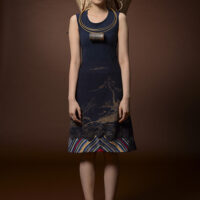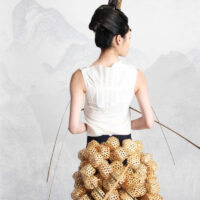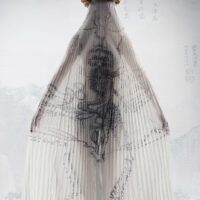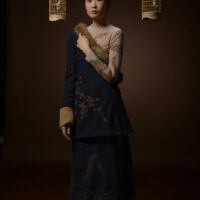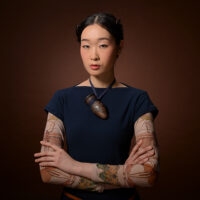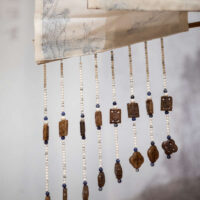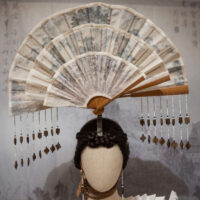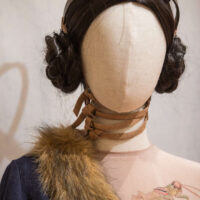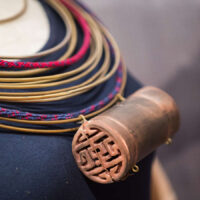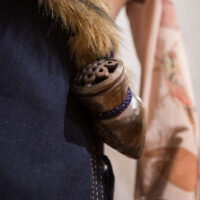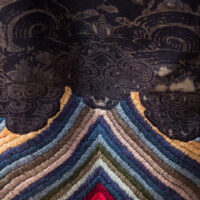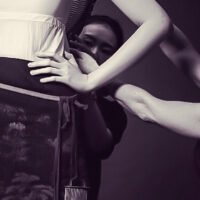Cricket Songs
Materials:
Late Summer Calling Song No. 1
Bamboo, Brass, Japanese Bridal Polyester Voile, Laser-etched Wool Double Weave, Synthetic Wig, Iron Weights, Arduino Micro processes, Motion sensor, Electrical Wire, Speakers, Sound recording
Late Summer: Calling Song No. 2
Ceramic, Brass, Cotton Braiding, Electronics, Blue Poly Cotton Knit, Laser-etched Wool Double Weave, Cotton Embroidery, Synthetic Wig, Rattan, Raffia, Arduino Micro processes, Motion sensor, Electrical Wire, Speakers, Sound recording
Early Autumn: Courting Song No. 1
Japanese Bridal Polyester Voile, Sublimation Printed, Steam Pleated, Cotton Gauze, Bamboo, Electronics, Artificial Bird
Early Autumn: Courting Song No. 2
Digitally Printed Tyvek, Laser-etched Double Weave Wool, Raffia, Bamboo, Electronics, Cotton Braiding, Brass Cricket, Steel, White Polyester, Timber, Burned Jade, White Howlite, Lapis Lasuli Beads, Brass, Arduino Micro processes, Motion sensor, Electrical Wire, Speakers, Sound recording
Mid Autumn: Song of Celebration No. 1
Laser-etched Wool Double Weave, Synthetic Fur, Machine Embroidery, Skin Tone Netting with Heat Press Cricket Image, Brass, Electronics, Bamboo, Jute, Arduino Micro processes, Motion sensor, Electrical Wire, Speakers, Sound recording
Mid Autumn: Song of Celebration No. 2
Skin Tone Netting with Heat Press Cricket Image, Laser-etched Wool Double Weave, Steel, Electronics, Aluminium, Wood with Brass Inlay, Brass, Synthetic Wig, Bamboo, Raffia, Jute, Arduino Micro processes, Motion sensor, Electrical Wire, Speakers, Sound recording
Late Autumn: Song of Dominion No. 1
Steel, Leather, Ceramic, Cotton, Electronics, Laser-etched Wool Double Weave, Synthetic Fur, Cotton Lining, Cotton Hand Embroidery, Sublimation Printed Polyester Stretch Netting, Brass, Synthetic Wig, Bamboo, Arduino Micro processes, Motion sensor, Electrical Wire, Speakers, Sound recording
Late Autumn: Song of Dominion No. 2
Blue cotton T-shirt with Sublimation Printed Stretch-Netting Sleeves, Laser-etched Wool Double Weave, Brass, Gourd, Ceramic, Cotton Braiding, Raffia, Synthetic Wig, Arduino Micro processes, Motion sensor, Electrical Wire, Speakers, Sound recording
Concept:
Cricket Songs is a collection inspired by the fascination with keeping crickets and birds in Chinese culture. Historically, the art of keeping crickets as pets included delicate artefacts such as pots, cages and ticklers made of sandalwood, jade, ivory, ceramic or bamboo. Artefacts were designed for different seasons and served various functions, demonstrating the significance of crickets in Chinese history. This collection draws on this rich cultural heritage and a collaboration with Chan Chor-Kiu, a Hong Kong rattan weaver. Cricket Songs conveys the charm of different moments in the seasonal cycle.
The costumes combine traditional and contemporary techniques, paying homage to the cultural practice of keeping crickets and the crafting skills associated with it. Digital prints are combined with Shibori, a Japanese manual resist dyeing technique; and laser etching is combined with embroidery to create landscape imagery on a series of A-line skirts. The lower hem borders are embroidered with the pattern commonly seen on imperial gowns, celebrating the labour class with the noble embroidery decoration. Many components in the installation are handcrafted, such as the ceramic smoke-fired, gourd-shaped cricket cages and brass neck rings. The clothing and head pieces with birdcages seem to suggest a sense of leisure in the life of diligent labourers. In addition to visual elements, the viewer is emerged in an ambient soundscape of crickets chirping and birds singing. Each costume has a signature sound, forming a journey through a seasonal soundscape guided by the songs of crickets and visual costumes.
The Cricket Songs collection is divided into four sections. Late Summer “Calling Song”, Early Autumn “Courting Song”, Mid Autumn “Song of Celebration”, Late Autumn “Song of Dominion”. (each section has two costumes) As exhibition visitors move through the 4 sections they are guided by text panels sharing understanding of Cricket Culture, Cricket Phenology, Cultural Entomology, and Crickets and Emotions.
Late Summer “Calling Song”:
The song is an attractive melody to females and repulsive detractor of other males.
Chinese cricket culture spans 2000 years and can be divided into three eras. Prior to the Tang dynasty (500 B.C. – 618 A.D.) crickets were admired for their singing. During the Tang dynasty (618 – 906 A.D.) singing crickets were kept in captivity. Under the Song dynasty (960 – 1278 A.D.) cricket fighting became a popular sport. They have been symbols of luck and virtue since the Chun Qui period (770-476 B.C.) but by the time of the Tang dynasty they were kept as pets for their song. At this time, it was common to enhance, refine and heighten the volume of the insect’s “voice” by painting the stridulatory mirror of the front fore wing with a mixture of brass powder and rosin. Towards the end of the Ming dynasty, people started breeding crickets. By the Qing dynasty, their popularity was evident in the handcrafted cricket containers that were created with elaborate skill and the employment of professional caretakers for crickets in the palace so they could sing for the Emperor’s pleasure.
The cricket tube featured in this display is smoke fired from hand carved ceramic on cotton-braided brass neck-rings. Pots resembling jade were historically made from a specially treated clay called “Chen Ni” that had been soaked in water in a silk bag for several years. Flanagan created ceramic gourds using fine white stone clay, which was burnished, carved, and smoke fired. The skirt is double-weave merino lambs-wool laser-etched with a landscape inspired by a Ming Dynasty Gu-embroidery painting “Flowery Brook – Fisherman’s Retreat”[1] with hand embroidered cotton boarder. The headdress features an antique double-story bamboo cricket cage, found in a Hong Kong antique shop. The skirt is laser-etched with a Yuan Dynasty landscape by Ma Wan, Poetic Twilight Clouds (暮雲詩意圖).[2]
The bamboo balls featured in the bustle came from Shanghai Bird and Insect market. Up until this day, every summer there are people selling crickets in insect markets all over China. “From the end of May to the end of July, pedlars, found in food markets and along streets, sell hundreds of “Jiao Ge-Ge” (singing brothers) and “Jie-Er” (singing sisters) (Pemberton, 1990)”. Bamboo woven containers were commonly used as cheap vessels to sell crickets. A hole in the mesh would be widened by pushing with a cone shaped wedge, the live cricket dropped in and then the ball squeezed to push the mesh back together.
Endnotes
1. Hang Jian and Guo Qiuhui, Chinese Arts and Crafts. Cambridge University Press, 2012.
2. Shanghai Museum, China. Community Commons.
Early Autumn “Courting Song”:
The courting song is a soft and soothing sound.
Cricket Phenology:
The cricket’s loud singing voice has made a profound impression on Chinese culture. In early Chinese seal-script the word for Autumn “Qiu” is formed in the shape of crickets. The cricket’s seasonal behaviour is closely affiliated with that of farmers, this is evident in the book of “Shi Jing” (1100-600 B.C.) which reads: “In May, the “Shi Zhong” moves its legs; In June, the “Sha Ji” moves its wings; In July, the katydid is in the field; In August, the katydid is in the yard; In September it is at the door; In October, the crickets enter and crawl under our beds.” Another clear example of the relationship people had with the insects is found in an ancient story when the cricket, “Cu Zhi” is found singing indoors in October, which prompts the ladies to expedite their weaving efforts to ensure sufficient cloth for the coming winter. The garment displayed here features an early Ming dynasty image by Dai Jin, “Landscape in the Style of Yan Wengui”1 laser-etched into Merino lambs-wool double-weave.
Antique cricket cages collected from street markets and antique shops in Hong Kong are strung from a hand-woven and dyed raffia and jute belt. Forging and welding are techniques used by Flanagan to make steel buckles, headdresses and brass crickets in this collection. The headdress displayed here features bamboo fans covered in laser-cut calligraphy paper, influence by the Chinese ink-painting tradition of working in three spaces: fore, mid and background. The pleated top is digitally printed on Tyvek. The veiled figure wears hijab or burqa that has been hand stitched and steam pleated from Japanese polyester drawing on traditional Shibori technique. The veil features drawn thread work and sublimation printing of scientific illustrations of a cricket and its organs. The interplay of imagery between the body’s silhouette and the internal and external cricket images is a reflection on the close relationships between insects and humans and pays homage to their auspicious connection to fertility and good luck.
Endnotes
1. Image licensed under Community Commons.
Mid Autumn “Song of Celebration”:
this song follows the courting song and is the copulatory song of celebration after a successful mating.
Cultural Entomology:
Not only the Cricket song but their vitality is celebrated. Crickets lay hundreds of eggs and hence were elevated above other insects to be symbolic of thriving prosperity. In Chinese Medicine, “Ben Cao Gang Mo” the katydid was prescribed as an aphrodisiac. A traditional Chinese medicine scale made by a local Hong Kong craftswoman is featured in this headdress. The landscape laser-etched into the skirt is drawn from a 13th century painting by Huang Gong-Wang ( 黃公望 ), 1269-1354, 水閣清幽圖.1
The tradition of keeping insects as pets may have started among rural farmers and then introduced into the palace or visa-versa, but ultimately keeping singing insects was regarded as an elegant hobby. The symbol of the cricket can be found in traditional embroidery patterns in many parts of China. The fur/wool cap displayed here has embroidered cricket images on the ear flaps. The skirt depicts children playing with crickets, drawn from a 12th century image attributed to Su Han-ch’en from a larger scroll depicting games and pastimes of a hundred boys laser-etched into Italian double-weave, Merino lambs-wool.
Endnotes
1. Image source: http://www.art-virtue.com/painting/history/yuan/yuan.htm
2. Field Museum collection
Late Autumn “Song of Dominion”:
The cricket is also equipped with an aggressive song. It serves to detect males in the near vicinity.
Crickets and Emotions:
Gourds are a popular material used for cricket containers. This humble material is considered auspicious and is linked to the Taoist search for paradise. It’s moisture and resilience to the cold make it suitable for keeping live crickets. Growing gourds for this purpose involves rotating maturing gourds regularly to receive even sunlight and it was popular to scorch the surface with a hot iron to create decorative patterns. Lids were carved with lattice designs that functioned as breathing holes and enhanced sound transmission. There are examples carved with auspicious symbols made from sandalwood, jade, ivory, mother-of-pearl, and turtle shell.
Natural Gourds with lids of carved ceramic are featured in the designs displayed here. They are strung from a belt woven from raffia and jute fibres. The belt and corset were hand-woven on a domestic rigid-heddle loom. The skirt features a laser-etched Qing Dynasty landscape attributed to GUO MIN, “Wind and Snow in the Fir-pines”.1 The jacket draws on traditional Mongolian style and has hand-quilted running stitch borders. The border on the skirt is in the style of the yellow emperor’s robes, created by hand stitched rows of cotton satin-stitch. Each coloured stripe took around two-hours, so the time to embroider this border was approximately 330 work hours. The shirt is inspired by tattoo imagery and uses scientific illustrations sublimation printed onto skin-toned power-mesh. The landscape is from a Southern Song dynasty (1127–1279,) painting by Ma Yuan, 南宋 馬遠 高士觀瀑圖 冊頁 絹本, “Scholar viewing a waterfall”.2
Keeping crickets was often associated with bird keeping, both appreciated for their singing voices, but also the crickets were bred to feed the birds. Here a headdress with birdcages mimics the tradition of walking the birds for exercise, where swinging the cage meant the birds had to grasp their perch and thus they were exercised on a walk to the park or workplace, where the cages were then hung in the trees or awnings, while the owners met to play mahjong or conduct their daily business.
In the field, most singing insects sing in the autumn and die with Winter. As a symbol of autumn, they became associated with loneliness, sadness, pity for the fate of mankind and are thus used prolifically in Chinese poems. “Most of the ladies of the palace were concubines to the Emperor. With emperors typically having three thousand concubines, their life was typified by a rich material life but starved emotional and cultural experience. A similarity can be drawn between the concubines and their captive crickets in their golden cages. Rather than enjoying the sweet chirps of the crickets, the concubines heard a reflection of their own sadness and loneliness in the cricket’s chirp.” 3
Endnotes
1. Berkeley Art Museum and Pacific Film Archive.
2. Ex coll.: C. C. Wang Family, Gift of The Dillon Fund, 1973, collection of the Met museum.
3. Jin, Xing-Bao, Chinese Cricket Culture, Shanghai Institute of Entomology, Academia Sinica, http://www.insects.org/ced3/chinese_crcul.html
Exhibitions:
Makers Hand, Wangaratta Art gallery, Wangaratta Australia, 29th February – 5th April 2020
The Charismatic Rebirth of Yore, Taipei Museum of Contemporary Art, Taipei Taiwan 20th May – 22nd July 2018
Fashion + Paper, Scissors & Rock, 衣 + 包 剪 揼, Hong Kong Heritage Museum, Hong Kong
https://www.youtube.com/watch?v=Tpm2nht0bQc
24th September 2016 – 6th February 2017
Hong Kong Special Administrative Region of the Peoples Republic of China Grand Variety Show in Celebration of the 20th Anniversary of Hong Kong’s Return to the Motherland. Hong Kong Convention Centre, 1 July 2017.
Publications:
Catalogues
•Shirney Wong, Pei-Yu Liao. The Charismatic Rebirth of Yore, Taipei Cultural Foundation/ Museum of Contemporary Art, Taipei 2018, pp.7,20,132-141,153-155
•Apo Wu, Fashion + Paper, Scissors & Rock, Leisure and Cultural Services Department are, Hong Kong Heritage Museum, Hong Kong 2016, pp.6,12, 46-51, 71.
Journals
•Patricia Flanagan, Crafting Post-digital Fashion in Hong Kong, IN: Josepha Green (editor),
•The Journal of the Asian Arts Society of Australia – TAASA Review, The Asian Arts Society of Australia Inc, Sydney Australia, Vol. 27 No.1, March 2018, pp.22-24. ISSN 1037.6674
Media
CCTV
•President Xi Attends Gala Show for HK’s 20th Return Anniversary
https://youtu.be/3E8mOIzIxtw. 30 June 2017 See 2:39-2:46min
World Wide Web Internet
•Fashion Design Hong Kong, Fashion catwalk section in the Grand Variety Show in Celebration of the 20th Anniversary of Hong Kong’s Return to the Motherland
https://www.facebook.com/watch/?v=1687189241322041&extid=Eioi364t7zcNMrGV
Thanks:
Funding support from Hong Kong Heritage Museum
Special thanks Apo Wu, Meiyi Cheung, Bruce Bateman, Louis Ng, Lawrence Chan, Laura Keogh, Sue Midgley, Greg Northcoat.
